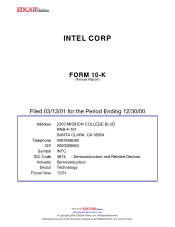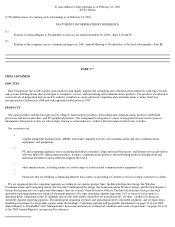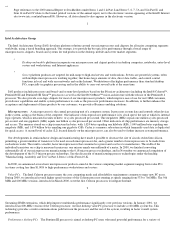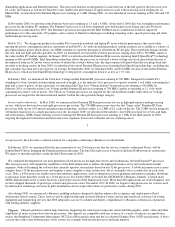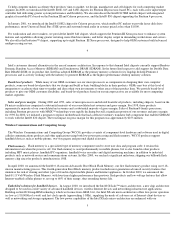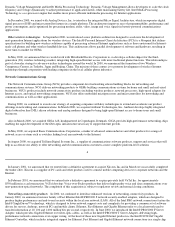Intel 2000 Annual Report Download - page 11
Download and view the complete annual report
Please find page 11 of the 2000 Intel annual report below. You can navigate through the pages in the report by either clicking on the pages listed below, or by using the keyword search tool below to find specific information within the annual report.
purchased. As a matter of industry practice, billback clauses are difficult to enforce. The quantity actually purchased by the customer, as well as
the shipment schedules, are frequently revised during the agreement term to reflect changes in the customer's needs. In light of industry practice
and experience, we do not believe that such agreements are meaningful for determining backlog amounts. We believe that only a small portion
of our order backlog is noncancellable and that the dollar amount associated with the noncancellable portion is not material. Therefore, we do
not believe that backlog as of any particular date is indicative of future results.
11
COMPETITION
Our goal is to be the preeminent building block supplier to the worldwide Internet economy. Our primary focus areas are the desktop and
mobile platforms, the server platform, and networking and communications including wireless communications, as well as new business
opportunities around the Internet. In each of these market segments, we compete, to various degrees, on the basis of functionality, performance,
quality, price and availability. We are engaged in a rapidly advancing field of technology in which our ability to compete depends upon our
ability to improve our products and processes, develop new products to meet changing customer requirements and reduce costs. Prices decline
rapidly in the semiconductor industry as unit volumes grow, further competition develops and production experience is accumulated. Many
companies compete with us in the various computing, networking and communications market segments and are engaged in the same basic
fields of activity, including research and development. Both within and outside the United States, these competitors range in size from large
multinational companies to smaller companies competing in specialized market segments.
The Intel Architecture Group operating segment supports the desktop, mobile and server platform initiatives. Our strategy for the desktop,
mobile and server platforms is to introduce ever-higher performance microprocessors and chipsets, developed for different market segments of
the worldwide computing market, using a tiered branding approach. To further enhance the acceptance and deployment of these products by
our customers, we also provide e-Business enabling solutions. In line with our strategy, we seek to develop higher performance
microprocessors based on the P6 micro-architecture specifically for each computing segment. We also plan to introduce higher performance
versions of processors based on the Intel NetBurst micro-architecture.
Our financial results are substantially dependent on sales of microprocessors by the Intel Architecture Group. A number of competitors
market software-compatible products intended to compete with Intel Architecture-based processors. We also face significant competition from
companies offering rival microprocessor architectures. The Celeron processor competes with existing and future products in the highly
competitive value PC market segment. The Pentium III
processor and the Pentium 4 processor compete with existing and future products in the
performance desktop and entry-level workstation market segment. Competitive product offerings in the performance desktop market segment
have recently increased. The Pentium III Xeon processor competes in the mid-range and high-end server and workstation market segments
with established products based on rival architectures.
Many of our competitors are licensed to use our patents. Furthermore, based on current case law, our competitors can design
microprocessors that are compatible with our microprocessors and avoid our patent rights through the use of foundry services that have licenses
with us. Competitors' products may add features, increase performance or sell at lower prices. We cannot predict whether our products will
continue to compete successfully with such existing rival architectures or whether new architectures will establish or gain market acceptance or
provide increased competition with our products. Future distortion of price maturity curves could occur if software-compatible products enter
the market segment in significant volume or alternative architectures gain market acceptance.
We plan to cultivate new businesses as well as continue to work with the computing industry to expand Internet capabilities and product
offerings, and develop compelling software applications that can take advantage of higher performance microprocessors and chipsets,
increasing demand for Intel's newer products in each computing market segment. We may continue to take various steps, including reducing
microprocessor prices and offering rebates at such times as we deem appropriate, in order to increase acceptance of our latest technology and to
remain competitive within each relevant market segment.
12
In the networking and communications infrastructure area, our strategy is to deliver both system-level communications building blocks at
various levels of integration and component-level silicon building blocks for networking and communications systems. We have made
acquisitions and expect to make additional acquisitions to grow the networking and communications areas. The network communications
silicon and network connectivity products from the Network Communications Group face competition from both established and emerging
companies. The competitors in these areas use aggressive product and acquisition plans in efforts to achieve leading-
edge market positions. The
Communications Products Group operating segment supports initiatives to deliver the system-level communications products directed at
service providers running e-Business data centers. The Communications Products Group focuses on selling its Intel NetStructure products to
OEM customers. The Communications Products Group also provides component-level products for converged voice and data communications
systems for the telecommunications industry. These products compete in the small and mid-sized enterprise market segments with established
products and leading
-
edge Internet communications systems and server products. We cannot predict whether our networking and

